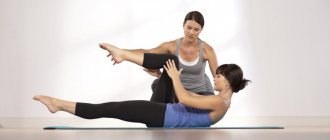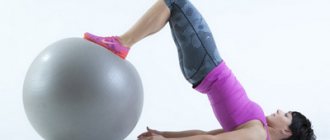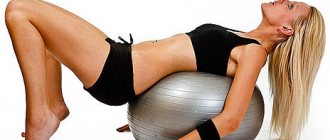With the onset of pregnancy and throughout its entire duration, the expectant mother needs to carefully monitor her health. To do this, you need to undergo medical examinations in a timely manner and follow the recommendations of doctors, eat right, avoid overwork and stressful situations, etc. The successful development of pregnancy is also influenced by the physical condition of the expectant mother - in the absence of contraindications, pregnant women are recommended to attend yoga classes , water aerobics or gymnastics.
- 2 The benefits of gymnastics during pregnancy in the second trimester
- 3 Contraindications to gymnastics
- 4 Gymnastics techniques in the second trimester of pregnancy
4.1 General gymnastics
4.1.1 Video: gymnastics in the second trimester of pregnancy
- 4.2.1 Video: exercises on a fitball for pregnant women
- 4.3.1 Video: breathing exercises for pregnant women
Gymnastics on a fitball for pregnant women. Video of exercises for pregnant women
A fitball is a large gymnastic ball, it is widely used in a variety of fitness areas. A fitball for pregnant women is especially convenient because it helps relieve stress from the back.
In the first trimester of pregnancy, you can exercise on a fitball with some caution. Starting from the third trimester, it is necessary to gradually reduce the load, and from the second half of the third trimester it is better to generally limit yourself to walking and breathing exercises. During pregnancy, you need to perform only a specially selected set of gymnastic exercises, taking into account the woman’s health. It is best to study individually at this time rather than attend group classes.
Gymnastics during pregnancy is only allowed for healthy women with an uncomplicated pregnancy. Therefore, before you start training, you must consult your doctor.
Each lesson should begin with a five-minute warm-up. You can do simple aerobic exercises or pedal an exercise bike. Monitor your heart rate carefully to avoid overload. After warming up, you can take a fitball for pregnant women and begin the main part of the workout.
- Sit on a fitball with your legs wide apart and your back straight. Take dumbbells in your hands, press your elbows to your body, now bend your elbows, lifting the dumbbells up. This exercise must be repeated eight times.
- Take the same starting position. Now raise your arms to the sides, slightly bending your elbows. Repeat this exercise eight times.
- Now sit on the exercise ball and lean forward slightly. Place one elbow on your thigh. Take a dumbbell in your other hand, bend it at the elbow and pull it back slightly. Now straighten your arm with the dumbbell at your elbow, while keeping your shoulder motionless. Repeat the exercise eight times.
- Sit on the floor with your legs crossed. Hold the exercise ball at chest level. Point your elbows to the sides. Now squeeze the exercise ball with your hands. This exercise must be repeated fifteen times.
- Sit on a fitball, bend your arms with dumbbells at a right angle in front of your chest. Now spread your arms to the sides without straightening them. Do this exercise fifteen times.
- Lie on the floor on your back and bend your knees. Place one on the fitball. Now roll the ball back and forth with your foot, you can also make circular movements. Switch legs. Do this exercise eight times.
- The starting position is the same as in the previous exercise. Place one foot on the ball and use the other foot to move as if you were riding a bicycle. Switch legs. Repeat the exercise eight times.
- Take the starting position from the previous exercise. Place one foot on the ball and bend the other at the knee and lift it up. Make circular movements with your feet. Now switch legs. Repeat the exercise eight times.
Fitball for pregnant women must be combined with breathing exercises, which must be performed in between exercises with the ball. Carefully monitor your well-being during exercise; if you feel dizzy or otherwise unwell, you should stop exercising. During training, do not use dumbbells heavier than 1 kg, do not hold your breath, and do not exercise for more than 40 minutes.
In the first trimester of pregnancy, you can exercise on a fitball with some caution. Starting from the third trimester, it is necessary to gradually reduce the load, and from the second half of the third trimester it is better to generally limit yourself to walking and breathing exercises. During pregnancy, you need to perform only a specially selected set of gymnastic exercises, taking into account the woman’s health. It is best to study individually at this time rather than attend group classes.
A set of recommended exercises on the ball
- Sit on the center of the ball with your feet wide apart. Cover the kneecaps with the palms of your hands, fixing them. Keep your body straight. Straighten your shins perpendicular to the floor. Move your pelvis back and forth, rolling the ball. The knees remain motionless. Inhale - tilt the pelvis back, exhale - move the pelvis forward.
The exercise loads the muscles of the abdomen, legs and buttocks, increases flexibility and mobility of the lumbar spine.
- Starting position as in the previous exercise. Move your pelvis left and right. Breathing is voluntary.
- Sitting on the ball, as in the first exercise, move your pelvis first clockwise, then counterclockwise.
- Sitting on a fitball, extend your arms to the sides. Pull them back, trying to bring your shoulder blades together, while bending your lower back a little. Inhale - arms back, exhale - return arms to their original position. The exercise develops the muscles of the thoracic spine and improves posture.
- Sitting on the ball, raise your arms horizontally and place your palms facing each other. Press your palms with force, as if crushing an invisible ball - exhale, relieve tension - inhale. The muscles of the chest and shoulder girdle work.
- While sitting on the ball, you should tense and relax the deep muscles of the pelvic floor, anus and perineum. By contracting the muscles, you can imagine that you are pulling the ball into yourself. You should not strain immediately to the maximum, but gradually, taking 3-4 pauses. It is necessary to hold the tension for several seconds at the highest point, then release it in the same way, in parts.
Do each exercise in one approach, 10-15 times.Exercising on the ball does not take a lot of time and effort from a pregnant woman, and the beneficial effect can hardly be overestimated . The ability to easily and without problems bear and give birth to a child, to have a strong and slender body without special trips to the gym - all these are quite good reasons to have this wonderful sports equipment at home. Fitball exercises guarantee a boost of vigor and health.
Below is a visual video with a set of exercises on a fitball:
What gymnastics are recommended in the second trimester of pregnancy (photo and video tips)
If you are expecting a baby, we sincerely congratulate you! A new life is now developing in you. And what it will be like depends entirely on you. During pregnancy, the whole world revolves around and takes on new colors. You are the center of the universe. In the first trimester, you probably studied special literature and watched educational videos for pregnant women. After which we understood the basic rules - the expectant mother must:
- eat properly and balanced;
- stay calm and have a positive attitude;
- prepare for the upcoming birth.
What does it mean? It is necessary to master a set of exercises designed specifically for pregnant women. This is best done in the 2nd trimester.
Fitness for pregnant women
Bent legs should form a right angle
We warn you right away - we are not talking about the fight against excess weight. All physical exercises recommended during pregnancy have the sole purpose of strengthening certain muscle groups. This is exactly the kind of gymnastics you need.
Experts in the field of gynecology and obstetrics advise starting classes in the 2nd trimester of pregnancy. This is due to the fact that if you are in this trimester, then at this time the threat of miscarriage has practically disappeared and, as a rule, toxicosis has passed. And the body begins to experience discomfort due to a significant increase in mass.
In particular, pregnant women experience back pain. So, we need gymnastics. To eliminate this condition, there are exercises on a sports ball - a fitball. First of all, you need to choose it correctly. To begin, simply sit on the ball. If your bent legs form a right angle (as shown in the photo), this is your option.
A set of simple exercises
It is best to start the complex with a warm-up. While sitting on the ball, smoothly tilt your head to one side and the other. Spread your arms and carefully turn your torso to the right and left. Do each exercise several times and move on to the main part.
The main part of the exercises for pregnant women is designed taking into account the fact that in the 2nd trimester the fetus begins to actively grow, and the woman experiences stress on the spine. Gymnastics on a fitball will reduce them.
- Sit on the ball, straight back, arms extended horizontally in front of you. Inhale – bend your left arm at the elbow and move it back, trying to press your shoulder blade against your spine. Exhale – arms in the starting position. Inhale - do the same with your right hand. Exhale – starting position. Be careful - no sudden movements during pregnancy!
- Sitting with a straight back on a fitball, bend your elbows and turn your palms up. Inhale – move your arms to the sides, trying to bring your shoulder blades together. Exhale – starting position.
- Starting position - as described for the first exercise. Exhale – bending your elbows, bend down (no more than 45 degrees!). Inhale – straighten and move your arms back, connecting your shoulder blades. Exhale - straighten up. Inhale – extend your arms forward.
To strengthen the chest muscles, we suggest you familiarize yourself with the variety of exercises shown in the photo. It is performed as follows - bring your arms together on your chest, join your palms and press them forcefully against each other.
Interesting: What blood type can a child have if his parents
The 2nd trimester of pregnancy is considered a safe period. And appropriate gymnastics will minimize physical problems.
- Sit on the ball, straight back, arms extended horizontally in front of you. Inhale – bend your left arm at the elbow and move it back, trying to press your shoulder blade against your spine. Exhale – arms in the starting position. Inhale - do the same with your right hand. Exhale – starting position. Be careful - no sudden movements during pregnancy!
- Sitting with a straight back on a fitball, bend your elbows and turn your palms up. Inhale – move your arms to the sides, trying to bring your shoulder blades together. Exhale – starting position.
- Starting position - as described for the first exercise. Exhale – bending your elbows, bend down (no more than 45 degrees!). Inhale – straighten and move your arms back, connecting your shoulder blades. Exhale - straighten up. Inhale – extend your arms forward.
A set of exercises during pregnancy
A set of exercises with a fitball has its own characteristics in each trimester of pregnancy. The classes are united by a general rule: each workout should be preceded by a small exercise (warm-up). It is important for warming up the muscles and preparing the body for, albeit minor, loads.
Let's take a closer look at the features of the exercises for each period of gestation and the technique for performing them.
In the 1st trimester
Be sure to discuss your decision to use a fitball with your doctor. In the first period of waiting for the baby, it is important not to overload the body and not forget about rest.
The set of classes for this stage includes the following:
- Sit on the ball and rotate your pelvis in a circle in different directions, about 10 times in one direction and 10 times in the other direction.
- Sitting cross-legged on the floor, extend your arms up above your head, placing the fitball on them. Try making circular movements with your body clockwise, then in the other direction. The main rule of this exercise is a perfectly straight posture.
- Sitting on the floor, hold the fitball between your legs and do the following movements: alternately squeeze and unclench the ball with your feet (about 20 times).
- If your stomach is not yet enlarged, try lying down on the equipment with your feet on the floor and slowly ride it from your lower abdomen to your chest and vice versa.
- In a sitting position, lean in different directions. At the same time, remember that your back should be perfectly straight, your legs should be shoulder-width apart, and your arms should be in different directions. You only need to bend over while exhaling. One approach includes 10 inclinations (2 approaches are recommended).
Important! Keep track of your training time; it should not exceed 10–15 minutes in the first trimester.
The optimal time is 8 minutes.
Keep your movements slow and smooth. Jumping and stretching are strictly prohibited. Fitball exercises in the 1st trimester: video
In the 2nd trimester
The best time for training is the 12th–14th week. During this period, the woman’s condition normalizes and attacks of toxicosis decrease. It is recommended to perform each movement approximately 10 times, 2-3 approaches. Exercises during this period are aimed at training muscles.
- While sitting on the ball, place your hands on your shoulders and alternately align them in front of you. At the same time, you should move forward a little with the fitball. The main rule is a perfectly straight back.
- The “bending back” exercise is also done while sitting on a ball. It consists of moving your arms back and bringing your shoulder blades together as much as possible, bending back a little.
- The set of exercises of this period includes turns. They are done while sitting on your heels. The equipment must be held at arm's length. Rotate your chest to the left (as you inhale), doing the same manipulations with the fitball in your hands. After returning to the starting position (as you exhale), turn to the right.
- Lie down on the floor and “hug” your wayward exercise machine with your knees bent. After this, tilt your legs to the right and left, but at a slight angle so as not to strain your abdominal muscles. In a similar position, you can do another exercise: here you need to tilt your legs one by one and place them back on the equipment.
- Sitting on the ball, spread your legs in different directions, and lean your hands on your equipment. Try to lean as far as possible to the left, then to the right. In this case, you need to balance with your legs and arms to maintain balance.
Important! For this stage of pregnancy, abdominal exercises and those that are accompanied by heavy loads on the back are contraindicated.
Exercises for pregnant women 2nd and 3rd trimester: video
In the 3rd trimester
During the last period of pregnancy, carefully monitor your well-being and listen to your body’s signals. You can’t overload, it’s better to do fewer exercises, but do them regularly.
Here are examples of what can be done if there are no contraindications:
- Lie on your side with your head on your arm. One leg is bent at the knee, place the other on an anti-stress ball. Roll the equipment with your foot towards the perineum area, while bending your leg.
- Sit on the ball and try to breathe shallowly like a dog.
- Taking a comfortable position, sitting on a fitball, alternate contraction and relaxation of the vaginal muscles.
- Standing perfectly straight, place one foot on the ball and easily move the foot with the ball in a circle. Then do the same with the other leg. If you have difficulty maintaining your balance, you can use your hands to support yourself.
- Take the ball in your hands and lift it above your head, then move your hands with the ball back a little, while alternately putting your right and left leg back.
- Do the exercise called “rolling” while leaning on a wall. The ball must be held between the back and the wall and slowly lowered down (while rolling the fitball) until the legs are bent at the knees at an angle of 90°. Then climb back up.
Important! If you experience the slightest deterioration in your health, contact your doctor immediately.
Fitball exercises in the 3rd trimester: video
Exercises for pregnant women in the 1st, 2nd, 3rd trimester
Exercises for pregnant women vary by trimester in their intensity and nature of the load. If you want to maintain good shape and well-being throughout the entire 9 months and easily survive childbirth, do not forget about simple gymnastics. Let's look at the exercises recommended by gynecologists and sports trainers for a particular stage of pregnancy.
1st trimester
The first 12-14 weeks of embryo development are the most dangerous for it. That is why it is recommended to limit physical activity during this period. Under no circumstances should you put stress on your abs, as this can cause spontaneous miscarriage. But you can train your hips and perform breathing exercises that are very useful and necessary for expectant mothers.
So, exercises for pregnant women in the 1st trimester are simple and effective.
1. To perform this you will need a chair with a backrest. Leaning your hands on the back of the chair, perform not very deep squats with your legs spread to the sides. It is recommended to alternate this exercise with raising on your toes.
2. Strengthen the chest muscles and improve its shape. It's no secret that during pregnancy and after childbirth, many women's breasts lose their shape. This is unlikely to happen if you perform this simple exercise. Bring your arms together at chest level, clasp your palms. The exercise consists of trying to close your palms as tightly as possible; while doing this, you can feel the pectoral muscles working perfectly.
3. Exercise for the oblique abdominal muscles. Leaning on the back of the chair, cross your leg forward, then sideways and back. This serves as a prevention of stretch marks and good preparation for childbirth.
4. Pelvic rotation. It's very simple - perform circular movements with your pelvis in one direction and the other. Feet are shoulder-width apart and slightly bent at the knees.
5. And this exercise can be performed in any quantity, at any time and almost anywhere. Perform circular rotations with your feet. Rise on your toes, you can even sit. This helps to avoid varicose veins and leg cramps. Especially recommended for women who spend a lot of time sitting.
2nd trimester
Let's continue our brief review and look at recommended exercises for pregnant women in the 2nd trimester. This period is the safest during pregnancy and favorable for physical activity. The risk of a threatened miscarriage is quite low, and women feel well - the symptoms of early toxicosis have already disappeared, and their psychological state has improved due to the awareness of their situation and all the joy that lies ahead.
Exercises for the second trimester are aimed primarily at the pelvic area. Regular implementation of them helps to avoid such troubles as urinary incontinence, which often occurs in women over 30-35 years of age who give birth repeatedly. The result will be most effective if you perform Kegel exercises along with the ones below.
It is recommended to exclude exercises where the load falls on one leg and exercise in a brace, starting from 16-18 weeks, when the uterus has already grown significantly and the expectant mother becomes less agile. It is also not recommended to do exercises lying on your back, only on your side, so that the uterus does not compress the vena cava and does not provoke a lack of oxygen in the fetus.
1. We start with a warm-up. Sit on a hard surface and cross your legs in front of you. Turn your head in one direction and the other. The next exercise is smooth turns of the body with arms spread to the sides.
2. The next exercise is to sit in the little mermaid pose and stretch your arm up as you inhale, and as you exhale, bring it behind your head.
3. For the oblique abdominal muscles in the second trimester, the exercise is slightly different. It is performed lying on your side, arms lying on top of each other and extended forward. You need to rotate your upper arm 180 degrees by moving your body, then return it to its original position.
4. Exercise for the chest muscles (see first trimester).
5. Sit so that your buttocks are on your heels. Extend your arms forward and touch your forehead to the floor. This has a great relaxing effect. You can spread your knees a little so that your tummy lies between them.
3rd trimester
Childbirth is approaching, weight is growing, and doing even the simplest exercises becomes boring and difficult. But here exercises for pregnant women on a fitball - on a special gymnastic ball - come to the rescue. You can do them yourself at home (you just have to buy a ball first), or at a pregnancy center. Why fitball and not regular exercises? It can also be done, but exercises on a fitball are more effective and interesting. In addition, exercises on a gymnastic ball are very convenient and comfortable for expectant mothers during advanced pregnancy. The recommended exercises can be figuratively divided into three categories: for the buttocks and thighs, for the arms, for the chest.
1. You will need light dumbbells weighing no more than 1 kilogram. While sitting on the ball, you need to bend your arms alternately.
2. While sitting cross-legged on the floor, squeeze the ball lightly and rhythmically with your hands - this is a great simple exercise for the pectoral muscles.
3. If you are not too uncomfortable lying on your back, then you can try doing this exercise for 1-2 minutes, this is an excellent prevention of varicose veins. Lying on your back, you need to put your foot on the ball and roll it back and forth or make circular movements.
Do not forget that exercises for pregnant women in the 3rd trimester very often cause uterine tone, such is physiology. If you feel pain or your heart rate increases, stop warming up immediately. In this case, it is better to do breathing exercises, which we will discuss below. There are also medical contraindications to any type of physical activity; you should always remember them.
1. Some chronic diseases (so you should talk to your doctor before starting exercise).
2. With pronounced early toxicosis.
3. For bloody vaginal discharge.
5. With polyhydramnios.
And finally, breathing exercises. They serve as a kind of relaxation. If you breathe correctly at all stages of childbirth, you can significantly reduce the pain effect. But without regular training and concentration, this is practically impossible.
1. Diaphragmatic breathing. Place one palm on your stomach, the other on your chest and take deep breaths. Make sure that when you inhale, only your stomach rises and your chest remains motionless. Breathe through your nose.
Interesting: Oligohydramnios at 38 weeks of pregnancy forum
2. Chest breathing.
a) Place your palms on your ribs, spread your elbows to the sides. When breathing, your elbows should slide to the sides, and your stomach and chest should remain in the same position.
b) Place one hand on your chest and the other on your stomach. When inhaling, the chest rises, the stomach is motionless.
It is very important not to hold your breath when performing breathing exercises, otherwise the child may experience hypoxia. Class duration is 30-40 minutes.
5. And this exercise can be performed in any quantity, at any time and almost anywhere. Perform circular rotations with your feet. Rise on your toes, you can even sit. This helps to avoid varicose veins and leg cramps. Especially recommended for women who spend a lot of time sitting.
What to do with the fitball after?
- The ball cannot be replaced after birth. If the perineum had to be cut during labor, doctors will not allow the woman to sit for a week to a month (depending on the severity of the stitches and the cut). The ball will lend a helping hand in such a situation. It is safe and comfortable to sit on.
- As soon as the recovery stage after childbirth has passed, a woman can actively exercise on a gymnastics assistant without paying a lot of money for attending aerobics or fitness. Today you can find a large number of lessons online and practice on your own at home. Classes will help you quickly remove a soft belly and give it an elastic shape, as well as get rid of extra pounds.
- Don't forget about the baby. For him, this will subsequently become his favorite device for play activities. Newborns from the first month of life can exercise on a gymnastic ball. It helps improve and develop the vestibular system. The child, with the help of an adult, lies down on the ball with his stomach, the mother carefully tilts it forward and then back, scrolls it clockwise and does the same in the opposite direction. Every woman can do such activities with her baby. And the child will squeal with pleasure.
- If the baby won’t leave his mother’s arms and doesn’t sleep well, the fitball will come to the rescue again. It makes rocking a baby ten times more convenient. The movements are smooth and remind him of that past life in his mother’s tummy. Any, even the most athletic and trained woman, will get tired of pumping while standing. A young mother already has a lot to do and problems in the first months of a newborn’s life; the ball will help you take a little break and relieve tension, at least when rocking the baby.
Fitball for pregnant women: safe physical exercise for expectant mothers
Pregnancy is a time of transformation for a woman. Not only her body changes, but also her psychological state. To maintain muscle tone, a cheerful mood, and quickly get back into shape after the birth of a child, you need to take care of your body, eat rationally and be sure to perform special gymnastics. Many people are afraid to do any physical exercise during this time, and some are simply lazy. This is a big mistake. Moderate physical activity is necessary at any stage of pregnancy, if it proceeds without pathologies. Physical education will help avoid excessive weight gain, reduce the likelihood of stretch marks, and keep the expectant mother’s muscles in shape. Fitball for pregnant women has become very popular.
This is explained by the fact that exercises on a fitball for pregnant women allow a woman to prepare her body for childbirth, strengthen her abs, perineal muscles, and develop good stretching. The ball can become a faithful assistant during the birth process.
What is fitball?
Fitball is a special large ball for fitness. Its homeland is Switzerland, so its second name is Swiss ball. It makes it possible to perform various exercises, as it can withstand heavy loads. You can sit on the fitball, lie down, and jump with it. This versatile tool for physical education is made of bright rubber. The fitball must have a built-in anti-explosion ABS system, which prevents it from suddenly deflating and injuring a woman. Thanks to this, if you accidentally puncture the ball, it will not explode, but will gradually release air.
Exercises with a fitball for pregnant women allow you to cope with back pain that arises due to the increased load on the spine of the expectant mother. These exercises have an undoubted advantage over strength training - they do not cause muscle pain and do not build them up. Before starting classes, you should consult your doctor. Gymnastics for pregnant women with a fitball has almost no contraindications, and many doctors recommend this type of exercise to women.
Contraindications
Despite the fact that exercises on a large ball are gentle and gentle for the expectant mother, they have their own list of contraindications. These include:
- hypertonicity of the uterus;
- heart disease;
- toxicosis;
- herniated intervertebral discs;
- elevated temperature;
- threat of miscarriage;
- stomach ache;
- arterial hypertension;
- renal failure;
- severe anemia;
- presence of bloody vaginal discharge;
- istic-cervical insufficiency;
- low location of the placenta, its presentation.
Important! Before starting training on the ball, you should consult a gynecologist to exclude the above pathologies during pregnancy.
How to choose the right ball?
To ensure that exercises on a fitball for pregnant women are useful, it is recommended that you purchase it for yourself individually. The balls differ in parameters.
How to choose a fitball for pregnant women? To pick it up correctly, you should sit down on the ball. If your legs, bent at right angles at the knees, rest freely on the floor, then the size is appropriate.
You can choose a ball based on data such as the woman’s height and the diameter of the ball:
- height up to 1.52 m – diameter 45 cm;
- 1.52-1.65 m – diameter 55 cm;
- above 1.65 – diameter 65 cm.
It is better to buy a fitball during pregnancy in specialized stores. In the markets it is easy to buy a fake, which can burst during classes. In this case, the expectant mother may be injured by falling from the ball.
Class Rules
There is a list of rules that a pregnant woman who decides to do exercises on a gymnastic ball must adhere to:
- It is recommended to conduct training in a special center under the guidance of experienced specialists.
- If you decide to practice at home, then choose the most spacious room and remove any sharp or cutting objects that could puncture the ball.
- Beginners are advised to cover the base of the ball with towels to avoid falls if they lose their balance.
- It is important that your breathing is moderate while exercising and balancing on the ball.
- Make sure that your equipment does not overheat, that it does not lie close to heaters or in the open sun.
- If your health has worsened (fever, dizziness, stomach ache, nausea), exercise is strictly prohibited.
- You cannot overload the body: exercise should be moderate.
- It is important to monitor your heart rate and pulse rate.
- It is recommended to do the training in the morning or in the evening, before going to bed.
- In the 1st and 3rd trimesters, the duration of training can be 10–15 minutes, in the second – up to 30 minutes.
- If you did fitball before pregnancy, then forget the exercises you did. A pregnant woman is strictly prohibited from performing complex gymnastic exercises - only the recommended set of exercises.
Check out the recommended exercises for pregnant women: in the second trimester, in the third trimester.
So, a fitball can be called the optimal fitness equipment for pregnant women. Classes on it will help you properly prepare for childbirth and train muscle groups that will be involved in the birth process. The main rule of such training is to strictly coordinate it with your doctor and choose the right set of exercises, provided that the pregnancy proceeds without problems.
Pregnancy Exercises for pregnant women Exercises on fitball
What is a fitball used for during pregnancy?
Exercises for pregnant women with a fitball allow the expectant mother to:
- relieve tension from the spine;
- relax the muscles surrounding the spinal column;
- improve the functioning of the respiratory system;
- activate the circulatory system;
- normalize heart function;
- increase blood circulation in all organs.
Exercises with a fitball for pregnant women allow you to keep your pelvic muscles in shape. This makes it possible to minimize the likelihood of injuries and perineal ruptures during childbirth. Such exercises for pregnant women are an effective means of preventing kidney and bladder diseases and uterine prolapse. During exercise, the back and abdominal muscles are strengthened, which is a great advantage during childbirth. Gymnastics with a fitball for pregnant women allows you to improve blood circulation in the uterus and, accordingly, improve the nutrition of the fetus. It helps prevent stagnation of venous blood and the appearance of hemorrhoids.
A fitball for pregnant women will be a good helper in everyday life. It can be used as a chair while watching TV or rocking on it. This allows you to cope with back pain and relax your muscles.
The ball will be useful to the expectant mother during childbirth. It allows you to reduce pain during contractions and use your energy sparingly during this period. With short jumps on a fitball, additional blood flow occurs to the pelvic organs and, due to this, accelerated dilatation of the cervix. Read more about the stages of cervical dilatation →
Exercises on a fitball for pregnant women are recommended to begin after 12 weeks. During this period, the expectant mother is less likely to be bothered by toxicosis, and the likelihood of miscarriage is minimal. Before you start exercises for pregnant women on a fitball, you should consult your doctor. It will be very good if a set of exercises is selected by a competent instructor. It is advisable not to invent them yourself.
Gymnastics on a fitball for pregnant women has a minimum of contraindications, but they still exist. These include:
- threat of miscarriage;
- increased uterine tone;
- severe back diseases;
- isthmic-cervical insufficiency.
The advantages of this type of gymnastics
Why should you prefer fitball exercises to other types of gymnastics during pregnancy?
The fitball relaxes, relieves tension, relieves stress on the spinal column, strengthens the muscles of the abdominals, hips, and perineum. Pregnant women need all this not only in order to bear and give birth to a healthy child without any problems, but also for the speedy recovery of already accomplished mothers after childbirth.
And thanks to Kegel exercises, designed to work out the pelvic muscles (which cannot be strengthened in any other way), when the time comes, your baby's head will turn exactly as it needs to in order to pass through the birth canal smoothly.
Since there are a number of contraindications for training with a gymnastic ball, you should consult your doctor before starting them.
Fitball exercises have many positive aspects:
- tension is relieved from the main part of the axial skeleton;
- the muscles that support it relax;
- the activity of the respiratory system is optimized;
- blood flow and microcirculation increases;
- metabolism is activated;
- the functioning of the heart muscle improves.
The release of endorphins during exercise affects the mood of a pregnant woman, and strengthening the pelvic muscles helps reduce the risk of ruptures during childbirth. In addition, the processes of intercellular nutrition are improved, which means that more oxygen reaches the fetus, while decay products are eliminated faster.
Exercises on a fitball for pregnant women are a good prevention of hemorrhoids - a real scourge of expectant mothers, as well as diseases of the urinary system and kidneys.
Be sure to check out:
Depending on the stage of pregnancy, exercise sets may differ. They are selected depending on the trimester, contraindications and individual characteristics of the expectant mother.
Fitball exercises
Let's look at the features of ball exercises in different trimesters.
In 1st trimester
Fitball exercises for pregnant women are usually not performed in the 1st trimester. During this period, it is recommended to minimize physical stress on the expectant mother’s body so as not to provoke a miscarriage. This is especially true for those women who did not engage in any sports before conception.
If the expectant mother is accustomed to physical activity, then exercise for pregnant women on a fitball can begin in the second half of the 1st trimester. It is recommended to use only those exercises that are designed specifically for women expecting a baby.
Fitball exercises for pregnant women in the 1st trimester are quite simple and are performed 3-4 times. At this time, it is important to dose the load correctly and not overexert yourself. Before you start exercising on the ball, you need to warm up your muscles. To do this, swing your arms, walk in place, and turn your head for 5 minutes. If gymnastics with a fitball for pregnant women at some point begins to cause discomfort or pain to the woman, then the exercises should be interrupted and rest. During this period, you can load the muscles of the hips and shoulders, but exercises with the press should be postponed until a later time.
Here are some of the exercises allowed during this period:
- Lie on your back, bend your right leg and place it on the ball, resting your foot on it. The bent left leg should rest on the floor. Straightening your right leg, slowly roll the ball back and forth. Repeat the same with your left leg.
- Sit on a fitball, bend your arms with dumbbells at an angle of 90°. Without straightening them, move them apart and return them to their original position.
- Sit on the ball, spread your legs wide. The torso should be slightly tilted forward. Place your elbow on your thigh with one hand. Take the other dumbbell and bend it at a right angle, while moving your elbow and shoulder back. Next, you should straighten and bend your arm at the elbow again.
Interesting: How to register during pregnancy
In the 2nd trimester
During this period, you can do more intense exercises with the ball, since the likelihood of miscarriage has already decreased.
Fitball classes for pregnant women in the 2nd trimester include:
- Stretching exercises;
- Relaxation exercises;
- Exercises to train the muscles of the perineum.
Stretching exercises
The first group includes exercises for the back muscles. To perform them, you need to sit on the ball, you can lean on it with your hands. Then you should rock, rotate, and move back and forth with your pelvis. Such skills will be useful in the future during childbirth. Exercises on a fitball for pregnant women, carried out in the 2nd trimester, will help a woman take her mind off pain during contractions. And during the period of bearing a child, they relieve lower back pain and relieve tension in the back muscles.
The following exercise will also help strengthen your back muscles: sit on the ball, turn your torso and touch the opposite leg as far as possible. The muscles of the shoulder girdle and lower back will become stronger if you roll the fitball toward and away from you while bending over.
In addition to this, strengthening and stretching the leg muscles is recommended. To do this, sit on the floor, spread your knees and squeeze the ball with them. This action must be repeated several times until slight fatigue appears. Then, sitting on the fitball, you should alternately reach your right foot with your right hand and your left foot with your left hand.
To develop arm muscles, you can squeeze a fitball with your outstretched arms. The following exercise allows you to develop stretching and strengthen your buttocks: you should lean your chest on the ball, cross your arms under your chin, and alternately swing your legs.
Exercises for pregnant women on a fitball in the 2nd trimester should help strengthen the abdominal muscles. This must be done carefully, since increased loads on this area during pregnancy are prohibited. One of the recommended exercises: lean on the ball with your back and shoulder blades, bend your knees at an angle of 90°, put your hands behind your head. Next, the upper body is lifted with a delay of several seconds.
Relaxation exercises
Fitball exercises for pregnant women must include relaxation exercises. To do this, you need to lie on the ball with your chest, hugging it, kneeling and relaxing your back. The ability to relax will allow a woman to rest during childbirth and maintain strength between contractions.
2nd trimester is the optimal period for classes. But from about 18 weeks, it is recommended to wear a bandage while performing exercises, which will reduce the load on the back and abdominal muscles, and also prevent stretch marks.
In the 3rd trimester
Gymnastics for pregnant women on a fitball in the 3rd trimester includes all the same simple exercises as in earlier stages. At this time, it is already difficult for the expectant mother to do physical exercise, but she is quite capable of playing the ball. Exercises for pregnant women on a fitball in the 3rd trimester are of great benefit, since they are aimed at strengthening the muscles of the abs, lower back, buttocks, perineum, arms and legs.
Most maternity hospitals already have such balls, and they really help a woman during childbirth. If she is prepared and knows well what to do with the fitball during childbirth, then cervical dilatation occurs faster with the ball than without it. Exercises on a fitball for pregnant women in the 3rd trimester give the expectant mother the opportunity to learn all the intricacies of using it during childbirth.
At the end of pregnancy, unless there are contraindications, it is not recommended to completely remove physical activity. Even if it becomes difficult to exercise, you can perform relaxing exercises for pregnant women in the 3rd trimester on a fitball. At the same time, the intensity of the load and the pace of the exercises must be carefully adjusted taking into account the period and characteristics of the body of the expectant mother.
The expectant mother needs physical activity during pregnancy. But it must be agreed with a doctor. Gymnastics on a fitball for pregnant women in the early stages allows you to strengthen muscles, relieve tension from the back muscles, and in the 3rd trimester - prepare for childbirth.
Author: Olga Rogozhkina, doctor, especially for Mama66.ru
The benefits of gymnastics during pregnancy in the second trimester
From the second trimester of carrying a baby, the risks of spontaneous abortion are significantly reduced, signs of toxicosis disappear, and the body gets used to its new position. Therefore, from the point of view of gynecologists, the period from the 13th to the 28th week of pregnancy is the most suitable for playing sports. Exercise helps maintain a woman's weight, strengthens the pelvic floor muscles, which makes childbirth easier and reduces the likelihood of birth injuries.
Surgeons recommend that pregnant women do gymnastics in order to strengthen the spine and spinal muscles, because from the fourth month of expecting a baby, the load on the back increases every day due to the active growth of the fetus. Physical exercise helps get rid of pain in this area and prevents the development of various diseases of the musculoskeletal system. Sports activities also help prevent hemorrhoids, varicose veins and edema.
On the cardiological side, the benefits of gymnastics for expectant mothers include improving the functioning of the cardiovascular system and normalizing blood pressure.
In addition to its health-improving function, gymnastics also has great aesthetic value - the elasticity of the skin increases and the number of stretch marks on it decreases, and playing sports helps maintain good physical shape during pregnancy, which has a positive effect on the recovery of the body after childbirth.
Pregnant women who do gymnastics are less likely to experience insomnia, depression, mental disorders, etc. And a healthy nervous system is one of the keys to good health and a successful pregnancy.
Physical activity while carrying a child has a positive effect on the entire female body.
Gymnastics in the second trimester of pregnancy improves health and improves the mood of the expectant mother











